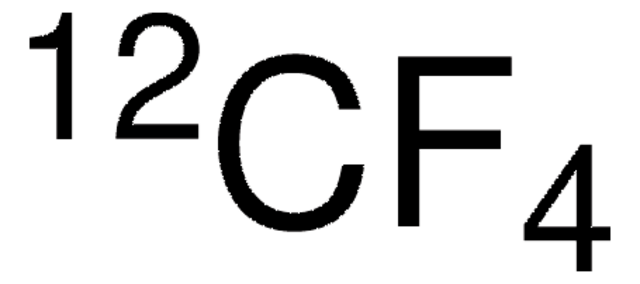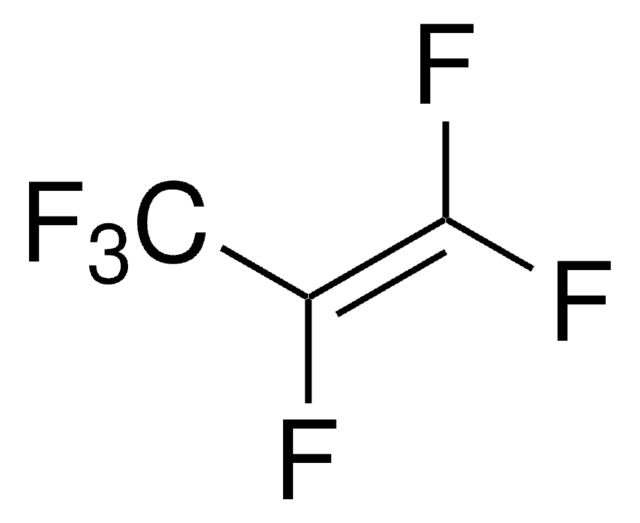295361
Hexafluoroethane
≥98%
Sinónimos:
CFC-116, Perfluoroethane
Iniciar sesiónpara Ver la Fijación de precios por contrato y de la organización
About This Item
Fórmula lineal:
CF3CF3
Número de CAS:
Peso molecular:
138.01
Número CE:
Número MDL:
Código UNSPSC:
12142100
ID de la sustancia en PubChem:
NACRES:
NA.22
Productos recomendados
densidad de vapor
4.7 (vs air)
presión de vapor
430 psi ( 21 °C)
Ensayo
≥98%
bp
−78 °C (lit.)
mp
−100 °C (lit.)
aplicaciones
PFAS testing
grupo funcional
fluoro
cadena SMILES
FC(F)(F)C(F)(F)F
InChI
1S/C2F6/c3-1(4,5)2(6,7)8
Clave InChI
WMIYKQLTONQJES-UHFFFAOYSA-N
Envase
Supplied in a carbon steel lecture bottle with a CGA180M/CGA110F needle valve installed.
Compatible with the following:
Compatible with the following:
- Aldrich® lecture-bottle station systems
- Aldrich® lecture-bottle gas regulators
Otras notas
See Technical Information Bulletin AL-151 Gas Regulators: Selection, Installation, and Operation
Información legal
Aldrich is a registered trademark of Sigma-Aldrich Co. LLC
Opcional
Referencia del producto
Descripción
Precios
espiga
Referencia del producto
Descripción
Precios
regulador
también adquirido normalmente con este producto
Referencia del producto
Descripción
Precios
válvula de control
válvula de purga
Referencia del producto
Descripción
Precios
Palabra de señalización
Warning
Frases de peligro
Consejos de prudencia
Clasificaciones de peligro
Press. Gas Liquefied gas
Código de clase de almacenamiento
2A - Gases
Clase de riesgo para el agua (WGK)
WGK 3
Punto de inflamabilidad (°F)
Not applicable
Punto de inflamabilidad (°C)
Not applicable
Equipo de protección personal
Eyeshields, Gloves, multi-purpose combination respirator cartridge (US)
Elija entre una de las versiones más recientes:
¿Ya tiene este producto?
Encuentre la documentación para los productos que ha comprado recientemente en la Biblioteca de documentos.
Ramin Tadayoni et al.
Ophthalmology, 118(1), 150-155 (2010-11-03)
To establish whether the success rate of surgery for small idiopathic macular holes (diameter, ≤ 400 μm) is significantly reduced if facedown positioning is replaced by simply taking care to avoid the supine position. Randomized, controlled, parallel-assignment, open-label, interventional, multicenter
Rubina Rahman et al.
Ophthalmic surgery, lasers & imaging : the official journal of the International Society for Imaging in the Eye, 42(3), 229-233 (2011-05-14)
To determine posterior capsule opacification (PCO) rate and identify contributory factors in a series of patients undergoing combined 23-gauge transconjunctival phacovitrectomy. Retrospective data on 221 consecutive patients operated on by a single senior surgeon using a standard technique were collected
Alexandre Guillaubey et al.
American journal of ophthalmology, 146(1), 128-134 (2008-04-29)
To compare two therapeutic modalities on anatomic and functional results after idiopathic macular hole (MH) surgery: seated vs face-down position. Multicenter, prospective, randomized trial. University Hospital Dijon and University Hospital Nancy. One hundred and forty-four patients (150 eyes) were enrolled
Timothy L Jackson et al.
Ophthalmology, 120(3), 629-634 (2012-12-06)
To study macular hole (MH) surgery in terms of baseline demographics, intraoperative complications, post-vitrectomy cataract, reoperation, and visual outcome. National Ophthalmology Database study. A total of 1078 eyes from 1045 patients undergoing primary MH surgery. Participating centers prospectively collected clinical
Joseph J Tseng et al.
American journal of ophthalmology, 147(5), 875-885 (2009-02-06)
To determine the influence of lens status on postoperative intraocular pressure (IOP) in eyes undergoing vitrectomy for repair of recurrent retinal detachment (RD) resulting from proliferative vitreoretinopathy (PVR). Retrospective, consecutive, nonrandomized, single-center series. One hundred and forty-five eyes with recurrent
Nuestro equipo de científicos tiene experiencia en todas las áreas de investigación: Ciencias de la vida, Ciencia de los materiales, Síntesis química, Cromatografía, Analítica y muchas otras.
Póngase en contacto con el Servicio técnico









